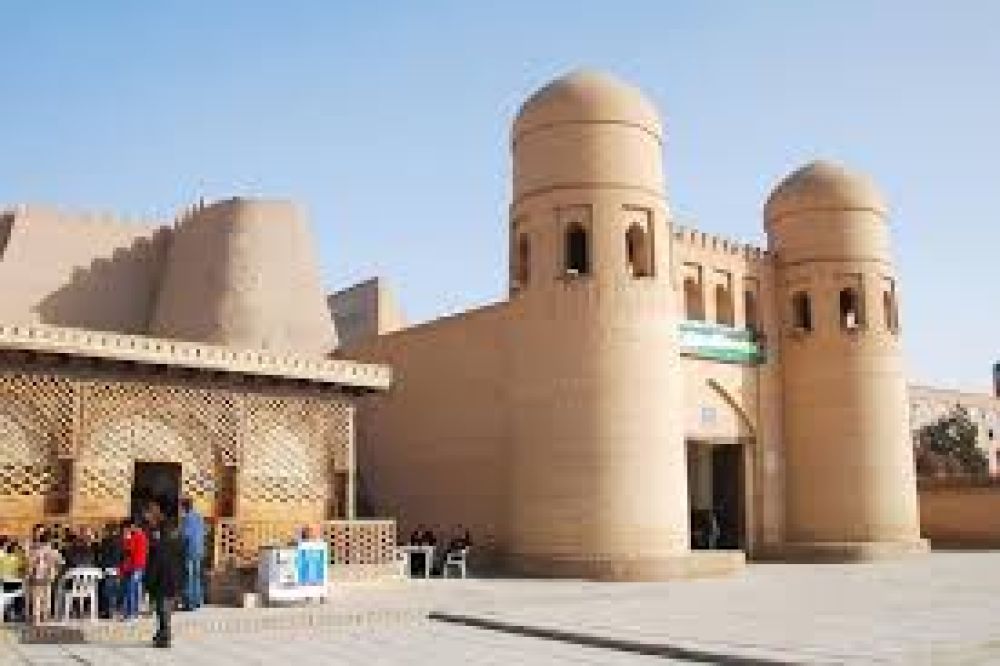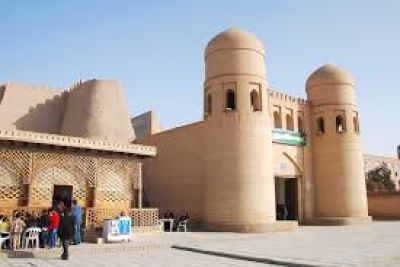

Discover the ancient Kunya-Ark Fortress, the once-mighty citadel of Khiva. Established in the 17th century, this historic fortress served as the Khan's inner citadel, containing the Khan's own living quarters, mosque, and mint, giving a unique insight into the lives of the Khivan rulers. The fortress is characterized by its thick walls, providing defense against invaders, and within its confines, visitors can explore the Summer Mosque, the Ak-Sheikh Baba observatory, and enjoy panoramic views from the watchtower. This activity is both educational and awe-inspiring, as you walk through centuries of history and touch the very walls that have withstood the test of time.
Step into the grandeur of the 19th-century Tash-Khovli Palace, an architectural masterpiece that served as a ruler's residence in Khiva. With its luxurious stone carvings and beautiful blue and white tiles, the palace is a spectacle of Khivan architecture. Visitors can meander through the palace's courtyards and view the harem, official reception hall (ishrat-khona), and the judicial chamber. Get an authentic glimpse of the Khivan royal lifestyle and marvel at the intricate Islamic patterns adorning the walls and ceilings. This palace is a visual treat for anyone interested in architecture, history, or cultural heritage.
The Islam Khoja Minaret is one of Khiva's most iconic landmarks, offering breathtaking views of Itchan Kala and the surrounding desert landscape. Standing tall at 45 meters, it is the highest minaret in Khiva, providing a vantage point for those willing to climb its spiraling staircase. From the top, visitors can witness the scale and beauty of the well-preserved Islamic architecture and the hues of the city's earthen colored buildings. While the climb might be challenging for some, the panoramic views upon reaching the summit are a just reward for the adventurous. The minaret is also a fine example of early 20th-century Islamic architecture with its intricate brickwork and blue tile bands.
Kalta Minor, commonly referred to as the 'Short Minaret,' is an unfinished minaret that is as mysterious as it is magnificent. Prominent for its thick, bulbous shape and stunning turquoise tiles, it was intended to be the tallest minaret in the world before construction halted due to the death of its commissioner, Mohammed Amin Khan. The Kalta Minor offers visitors the chance to ponder the ambition of the Khiva rulers and the exquisite craftsmanship of the artisans of the time. Even in its incomplete state, this minaret is a compelling attraction for visitors, emblematic of the rich historical tapestry of Itchan Kala.
The Juma Mosque is an architectural wonder of Khiva, offering a tranquil and spiritual experience. Unlike typical mosques, it features a vast, open hall supported by 218 wooden columns, each uniquely carved and several centuries old. Legend suggests that the mosque was built on the site of a much older Zoroastrian temple. Entering the mosque, visitors are greeted with a sense of peace and a cool respite from the desert heat. The mosque's minimalist design allows for reflection and reverence, making it a must-visit for those seeking to understand the Islamic influence on the area and its continued cultural importance.
The Muhammad Rahim Khan Madrasah is a center of culture and education in Khiva's Itchan Kala. This 19th-century madrasah has beautiful blue-tiled domes and an intricately decorated iwan (entrance portal). Originally, the madrasah functioned as an Islamic school where students lived and studied. Nowadays, it serves as a museum exhibiting artifacts, manuscripts, and art from Khiva's history. Visitors can absorb the scholarly atmosphere and understand the importance of education in the Islamic world. The madrasah is also a great place to appreciate local handicrafts and the continuation of Khivan traditions.
Kuhna-Ark, which translates to 'Old Fortress,' is yet another of Khiva’s historical wonders. Built in the 12th century and expanded upon over subsequent centuries, it was the residence of the Khans and military governors. Inside the citadel, visitors can explore various buildings, including the Khan's harem, mint, stables, arsenal, mosque, and even a throne room. The citadel's high walls and watchtowers paint a vivid picture of the fortified city's military past. A visit to Kuhna-Ark is like stepping back into the medieval history of Khorezm, with striking views of Itchan Kala and insightful glimpses into the day-to-day affairs of the Khivan court.
The mausoleum of Pakhlavan Mahmud is a deeply sacred and artistic site in Itchan Kala. Pakhlavan Mahmud was a poet, philosopher, and wrestler, now revered as the patron saint of Khiva. The lavish mausoleum features a beautiful turquoise dome, and the interior is adorned with majolica tiles and intricate carved ganch (a type of alabaster). Visitors are welcome to pay their respects and admire the craftsmanship of this final resting place of one of Khiva's most famous sons. The Mausoleum also holds the tombs of several Khiva khans, adding to its historical and spiritual significance.
The Sayid Alauddin Mausoleum is a much older, 14th-century mausoleum and a true gem worth exploring. Dedicated to the Sufi Sheikh, Sayid Alauddin, the mausoleum is a masterpiece of the Khorezm architectural style with its turquoise-blue dome and intricate tile work. Although smaller than other monuments in Itchan Kala, it holds a serene and mystical charm. Photographers and history enthusiasts will find ample subject matter here, with this mausoleum illustrating the city's depth of history and its continuity of reverence for spiritual figures.
Witness the transformation of Itchan Kala as the day turns to night and the ancient city is illuminated under the stars. As the sun sets, the lighted minarets and madrasahs take on a magical quality that transports visitors to a bygone era. Walking through the quiet, cobblestone streets, one can appreciate the beauty and mystique of this UNESCO World Heritage site in a whole new light. The atmosphere is enchanting, perfect for an evening stroll after a day of exploration. This activity is a favorite for romantics, photographers, and anyone looking to see Itchan Kala’s iconic structures glow against the night sky.
